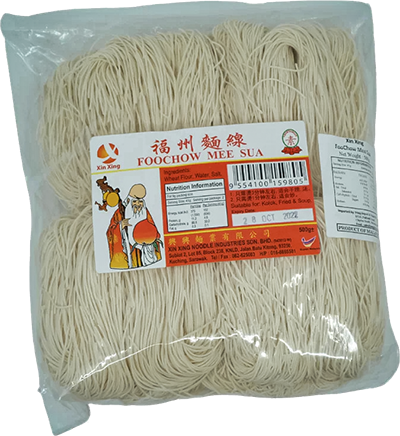Clem's
Chicken Broth Mee Sua
Mee sua
(long-life noodles), bee hoon (rice vermicelli)
and tang hoon (glass noodles) are all thin noodles used
in Chinese cuisine. Mee sua is made from wheat flour,
bee hoon from rice flour and tang hoon from starches
such as that from mung bean. Mee sua in particular,
originated from the Fujian Province in China (specifically the
Foochow region: mee sua is considered a Foochow
food icon) which is strange in that Fujian is a rice-growing
province (one would have expected a wheat flour noodle to come
provinces further north).
In Sarawak, the Foochows initially settled in the Sibu area and
in Malaya, Sitiawan. These two places are where mee sua
made in the the traditional way may be purchased. Mee sua
is still made via hand-pulling dough at the outdoor drying stage
(see video clip
here). This pulling (rather
than extrusion by which other noodles and pasta is factory made)
gives rise to noodles which vary in thickness with the middle
portions of the pull are thinner than the "head" and "tail"
portions. Mee sua which is thinner is used in noodle
soups whereas the thicker noodles are used in frying.
Due to convenience and availability in supermarkets, this was my
go-to brand in Kuching (made in Batu Kawa, Kuching):

When the term mee sua
is encountered in Chinese cuisine, it usually means a
slow-cooked chicken soup dish in which the noodles are found.
This noodle soup is often red in colour and alcoholic due to the
addition of both red wine and the lees from the latter's
fermentation.There are various ways in which this dish is made but I have a
recipe which I have used for a rich chicken noodle soup. I do not
use red wine or lees in my version. This is my Chicken Broth Mee Sua:
and this is how you can make it yourself:
INGREDIENTS
(for one serving)
-
Two pieces of Chicken Maryland.
Cut off the drumstick to use whole while the thigh part is cut into smaller pieces.
-
A thumb-sized portion of ginger, cut into matchsticks.
I have made versions of this dish with and without ginger. They taste very different.
I actually prefer the onion-only version.
-
One large onion, diced.
I have not seen this used in any of the mee sua recipes which I have found on the web.
However, onion adds another dimension (see below) to the flavour profile of the soup and its addition is highly recommended.
-
2 -3 pieces of dried shitake mushroom, soaked in hot water until plump.
-
Ground white pepper.
-
OPTIONAL:
-
a handful of dried lily flowers, soaked in hot water exchanged until the water is no longer coloured.
-
a handful of dried bean curd sticks broken into small pieces, soaked in hot water until soft.
Both of the latter add fibre to the dish.
-
Some pieces of potatoes to give some body to an otherwise clear broth.
-
-
Two (or more) skeins of dried mee sua noodles.

Mee sua
can come in different thicknesses: Skeins from two different
brands (Both from China)
China-made mee sua is often in skeins tied up with red
thread
Sarawak-made mee sua is coiled in patties
METHOD
-
If making the traditional version with ginger,
in some oil, fry the ginger matchsticks until golden brown.
When done, remove some for use as garnishing.
Omit this step for a Chicken Onion Broth version.
-
Into the same oil, add the chicken with ground pepper and fry to lightly brown the pieces.
-
Add enough hot water to make the soup.
-
Toss in the diced onion and soaked shitake mushrooms.
-
Slowly simmer cook for an hour or more.
I usually cook until the chicken is just about to fall off the bones.
Note:
If you wish to add lily flowers and bean curd sticks, add the soaked items half way through the cook.
-
In the meantime, hard boil an egg or two and shell them.
-
Towards the end of slow cooking, add your favourite flavouring condiments such as fish sauce, more ground white pepper.
In my case, I add Knorr chicken powder (see below) liberally to intensify the flavour.
-
Keep the broth simmering until you are ready assemble the dish and serve it.
-
When you are ready to serve (and not before) prepare the noodles by dunking a couple of skeins at a time for about 30 seconds or more in boiling water.
The noodles overcook easily (become too soft) so watch this process closely.
When soft enough, place the cooked noodles into the serving bowl.
-
Immediately ladle enough chicken broth to cover the noodles.
Add a chicken drumstick and other pieces from the broth, the shitake mushrooms and a hard boiled egg.
-
If you like your soup alcoholic, you can now add aliquots as you like of your favourite alcohol such as rice wine, distilled cooking rice alcohol, brandy, or as I do, vodka (Smirnoff red label [37.5% v/v] or blue label [50% v/v]).
-
Garnish with some of the fried ginger matchsticks and serve immediately before the noodles over-soften in the hot broth.

Clem's
Chicken Broth Mee Sua
Enjoy!
|
The flavour of onions in cooking Onions produce organosulfur compounds (thiosulfinates and thiosulfonates) when they are cut during food preparation (cell rupture releases alliinase which catalyzes the reaction which produces thiosulfinates and thiosulfonates from isoalliin, an odourless compound in onions). These and other onion molecules mellow out into tasty compounds during cooking. An important such flavour compound is 3-mercapto-2-methylpentan-1-ol (MMP) which apparently tastes of meat broth. What this means for a cook is that:
|
|
|
03 May
2024
Created by Clem Kuek

